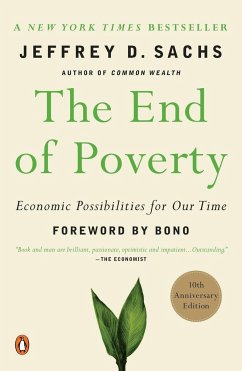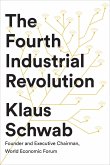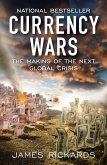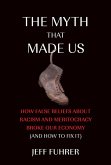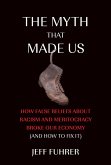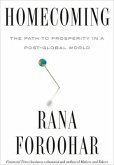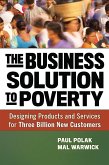12,99 €
inkl. MwSt.
Sofort lieferbar

6 °P sammeln
- Broschiertes Buch
- Merkliste
- Auf die Merkliste
- Bewerten Bewerten
- Teilen
- Produkt teilen
- Produkterinnerung
- Produkterinnerung
"Book and man are brilliant, passionate, optimistic and impatient . . . Outstanding." The Economist
The landmark exploration of economic prosperity and how the world can escape from extreme poverty for the world's poorest citizens, from one of the world's most renowned economists Hailed by Time as one of the world's hundred most influential people, Jeffrey D. Sachs is renowned for his work around the globe advising economies in crisis. Now a classic of its genre, The End of Poverty distills more than thirty years of experience to offer a uniquely informed vision of the steps that can…mehr
Andere Kunden interessierten sich auch für
![The Fourth Industrial Revolution The Fourth Industrial Revolution]() Klaus SchwabThe Fourth Industrial Revolution11,99 €
Klaus SchwabThe Fourth Industrial Revolution11,99 €![Currency Wars Currency Wars]() James RickardsCurrency Wars11,99 €
James RickardsCurrency Wars11,99 €![The Myth That Made Us The Myth That Made Us]() Jeff FuhrerThe Myth That Made Us31,99 €
Jeff FuhrerThe Myth That Made Us31,99 €![The Myth That Made Us The Myth That Made Us]() Jeff FuhrerThe Myth That Made Us21,99 €
Jeff FuhrerThe Myth That Made Us21,99 €![Homecoming Homecoming]() Rana ForooharHomecoming32,99 €
Rana ForooharHomecoming32,99 €![Clothing Poverty Clothing Poverty]() Andrew BrooksClothing Poverty12,99 €
Andrew BrooksClothing Poverty12,99 €![The Business Solution to Poverty The Business Solution to Poverty]() Paul PolakThe Business Solution to Poverty33,99 €
Paul PolakThe Business Solution to Poverty33,99 €-
-
-
"Book and man are brilliant, passionate, optimistic and impatient . . . Outstanding." The Economist
The landmark exploration of economic prosperity and how the world can escape from extreme poverty for the world's poorest citizens, from one of the world's most renowned economists
Hailed by Time as one of the world's hundred most influential people, Jeffrey D. Sachs is renowned for his work around the globe advising economies in crisis. Now a classic of its genre, The End of Poverty distills more than thirty years of experience to offer a uniquely informed vision of the steps that can transform impoverished countries into prosperous ones. Marrying vivid storytelling with rigorous analysis, Sachs lays out a clear conceptual map of the world economy. Explaining his own work in Bolivia, Russia, India, China, and Africa, he offers an integrated set of solutions to the interwoven economic, political, environmental, and social problems that challenge the world's poorest countries.
Ten years after its initial publication, The End of Poverty remains an indispensible and influential work. In this 10th anniversary edition, Sachs presents an extensive new foreword assessing the progress of the past decade, the work that remains to be done, and how each of us can help. He also looks ahead across the next fifteen years to 2030, the United Nations' target date for ending extreme poverty, offering new insights and recommendations.
Hinweis: Dieser Artikel kann nur an eine deutsche Lieferadresse ausgeliefert werden.
The landmark exploration of economic prosperity and how the world can escape from extreme poverty for the world's poorest citizens, from one of the world's most renowned economists
Hailed by Time as one of the world's hundred most influential people, Jeffrey D. Sachs is renowned for his work around the globe advising economies in crisis. Now a classic of its genre, The End of Poverty distills more than thirty years of experience to offer a uniquely informed vision of the steps that can transform impoverished countries into prosperous ones. Marrying vivid storytelling with rigorous analysis, Sachs lays out a clear conceptual map of the world economy. Explaining his own work in Bolivia, Russia, India, China, and Africa, he offers an integrated set of solutions to the interwoven economic, political, environmental, and social problems that challenge the world's poorest countries.
Ten years after its initial publication, The End of Poverty remains an indispensible and influential work. In this 10th anniversary edition, Sachs presents an extensive new foreword assessing the progress of the past decade, the work that remains to be done, and how each of us can help. He also looks ahead across the next fifteen years to 2030, the United Nations' target date for ending extreme poverty, offering new insights and recommendations.
Hinweis: Dieser Artikel kann nur an eine deutsche Lieferadresse ausgeliefert werden.
Produktdetails
- Produktdetails
- Verlag: Penguin US
- annotated ed
- Seitenzahl: 464
- Erscheinungstermin: 1. März 2006
- Englisch
- Abmessung: 211mm x 140mm x 31mm
- Gewicht: 378g
- ISBN-13: 9780143036586
- ISBN-10: 0143036580
- Artikelnr.: 22047119
- Herstellerkennzeichnung
- Libri GmbH
- Europaallee 1
- 36244 Bad Hersfeld
- gpsr@libri.de
- Verlag: Penguin US
- annotated ed
- Seitenzahl: 464
- Erscheinungstermin: 1. März 2006
- Englisch
- Abmessung: 211mm x 140mm x 31mm
- Gewicht: 378g
- ISBN-13: 9780143036586
- ISBN-10: 0143036580
- Artikelnr.: 22047119
- Herstellerkennzeichnung
- Libri GmbH
- Europaallee 1
- 36244 Bad Hersfeld
- gpsr@libri.de
Jeffrey D. Sachs
");} else { document.writeln("");} //--
"Jeffrey Sachs is that rare phenomenon: an academic economist famous for
his theories about why some countries are poor and others rich, and also
famous for his successful practical work in helping poor countries become
richer. In this long awaited, fascinating, clearly and movingly written
book, he distills his experience to propose answers to the hard choices now
facing the world." ?Jared Diamond, Pulitzer Prize winning author of Guns,
Germs and Steel and Collapse
");} else { document.write("");} // --
He has been cited by The New York Times Magazine as "probably the most
important economist in the world" and by Time as "the world's best-known
economist." He has advised an extraordinary range of world leaders and
international institutions on the full range of issues related to creating
economic success and reducing the world's poverty and misery. Now, at last,
he draws on his entire twenty-five-year body of experience to offer a
thrilling and inspiring big-picture vision of the keys to economic success
in the world today and the steps that are necessary to achieve prosperity
for all.
Marrying vivid eyewitness storytelling to his laserlike analysis, Jeffrey
Sachs sets the stage by drawing a vivid conceptual map of the world economy
and the different categories into which countries fall. Then, in a tour de
force of elegance and compression, he explains why, over the past two
hundred years, wealth has diverged across the planet in the manner that it
has and why the poorest nations have been so markedly unable to escape the
cruel vortex of poverty. The groundwork laid, he explains his methods for
arriving, like a clinical internist, at a holistic diagnosis of a country's
situation and the options it faces. Rather than deliver a worldview to
readers from on high, Sachs leads them along the learning path he himself
followed, telling the remarkable stories of his own work in Bolivia,
Poland, Russia, India, China, and Africa as a way to bring readers to a
broad-based understanding of the array of issues countries can face and the
way the issues interrelate. He concludes by drawing on everything he has
learned to offer an integrated set of solutions to the interwoven economic,
political, environmental, and social problems that most frequently hold
societies back. In the end, he leaves readers with an understanding, not of
how daunting the world's problems are, but how solvable they are-and why
making the effort is a matter both of moral obligation and strategic
self-interest. A work of profound moral and intellectual vision that grows
out of unprecedented real-world experience, The End of Poverty is a road
map to a safer, more prosperous future for the world.
On the web: http://www.earthinstitute.columbia.edu/endofpoverty/
");} else { document.write("");} // --
The path from poverty to development has come incredibly fast in the span
of human history. Two hundred years ago, the idea that we could potentially
achieve the end of poverty would have been unimaginable. Just about
everybody was poor with the exception of a very small minority of royals
and landed gentry. Life was as difficult in much of Europe as it was in
India or China. With very few exceptions, your great-great-grandparents
were poor and most likely living on the farm. One leading economic
historian, Angus Maddison, puts the average income per person in Western
Europe in 1820 at around 90 percent of the average income of sub-Saharan
Africa today. Life expectancy in Western Europe and Japan as of 1800 was
probably about forty years.
There was little sense a few centuries ago of vast divides in wealth and
poverty around the world. China, India, Europe, and Japan all had similar
income levels at the time of European discoveries of the sea routes to
Asia, Africa, and the Americas. Marco Polo, of course, marveled at the
sumptuous wonders of China, not at its poverty. Cortés and his
conquistadores expressed astonishment at the riches of Tenochtitlán, the
capital of the Aztecs. The early Portuguese explorers in Africa were
impressed with the well-ordered towns in West Africa.
Until the mid-1700s, the world was remarkably poor by any of today’s
standards. Life expectancy was extremely low; children died in vast numbers
in the now rich countries as well as the poor countries. Disease and
epidemics, not just the black death of Europe, but many waves of disease,
from smallpox and measles to other epidemics, regularly washed through
society and killed mass numbers of people. Episodes of hunger and extreme
weather and climate fluctuations sent societies crashing. The rise and fall
of the Roman Empire, for Arnold Toynbee, was much like the rise and decline
of all other civilizations before and since. Economic history had long been
one of ups and downs, growth followed by decline, rather than sustained
economic progress.
The Novelty of Modern Economic Growth
If we are to understand why vast gaps between rich and poor exist today, we
need therefore to understand a very recent period of human history during
which these vast gaps opened. The past two centuries, since around 1800,
constitute a unique era in economic history, a period that the great
economic historian Simon Kuznets famously termed the period of Modern
Economic Growth, or MEG for short. Before the era of MEG, indeed for
thousands of years, there had been virtually no sustained economic growth
in the world and only gradual increases in the human population…;
");} else { document.write("");} // --
Acknowledgements ix
Foreword by Bono xv
Introduction 1
1. Global Family Portrait 5
2. The Spread of Economic Prosperity 26
3. Why Some Countries Fail to Thrive 51
4. Clinical Economics 74
5. Bolivia's High-Altitude Hyperinflation 90
6. Poland's Return to Europe 109
7. Reaping the Whirlwind: Russia's Struggle for Normalcy 131
8. China: Catching Up After Half a Millenium 148
9. India's Market Reforms: The Triumph of Hope Over Fear 170
10. The Voiceless Dying: Africa and Disease 188
11. The Millennium, 9/11, and the United Nations 210
12. On-the-Ground Solutions for Ending Poverty 226
13. Making the Investments Needed to End Poverty 244
14. A Global Compact to End Poverty 266
15. Can the Rich Afford to Help the Poor? 288
16. Myths and Magic Bullets 309
17. Why We Should Do It 329
18. Our Generation's Challenge 347
Works Cited 369
Further Reading 372
Notes 376
Index 385
");} else { document.writeln("");} //--
"Jeffrey Sachs is that rare phenomenon: an academic economist famous for
his theories about why some countries are poor and others rich, and also
famous for his successful practical work in helping poor countries become
richer. In this long awaited, fascinating, clearly and movingly written
book, he distills his experience to propose answers to the hard choices now
facing the world." ?Jared Diamond, Pulitzer Prize winning author of Guns,
Germs and Steel and Collapse
");} else { document.write("");} // --
He has been cited by The New York Times Magazine as "probably the most
important economist in the world" and by Time as "the world's best-known
economist." He has advised an extraordinary range of world leaders and
international institutions on the full range of issues related to creating
economic success and reducing the world's poverty and misery. Now, at last,
he draws on his entire twenty-five-year body of experience to offer a
thrilling and inspiring big-picture vision of the keys to economic success
in the world today and the steps that are necessary to achieve prosperity
for all.
Marrying vivid eyewitness storytelling to his laserlike analysis, Jeffrey
Sachs sets the stage by drawing a vivid conceptual map of the world economy
and the different categories into which countries fall. Then, in a tour de
force of elegance and compression, he explains why, over the past two
hundred years, wealth has diverged across the planet in the manner that it
has and why the poorest nations have been so markedly unable to escape the
cruel vortex of poverty. The groundwork laid, he explains his methods for
arriving, like a clinical internist, at a holistic diagnosis of a country's
situation and the options it faces. Rather than deliver a worldview to
readers from on high, Sachs leads them along the learning path he himself
followed, telling the remarkable stories of his own work in Bolivia,
Poland, Russia, India, China, and Africa as a way to bring readers to a
broad-based understanding of the array of issues countries can face and the
way the issues interrelate. He concludes by drawing on everything he has
learned to offer an integrated set of solutions to the interwoven economic,
political, environmental, and social problems that most frequently hold
societies back. In the end, he leaves readers with an understanding, not of
how daunting the world's problems are, but how solvable they are-and why
making the effort is a matter both of moral obligation and strategic
self-interest. A work of profound moral and intellectual vision that grows
out of unprecedented real-world experience, The End of Poverty is a road
map to a safer, more prosperous future for the world.
On the web: http://www.earthinstitute.columbia.edu/endofpoverty/
");} else { document.write("");} // --
The path from poverty to development has come incredibly fast in the span
of human history. Two hundred years ago, the idea that we could potentially
achieve the end of poverty would have been unimaginable. Just about
everybody was poor with the exception of a very small minority of royals
and landed gentry. Life was as difficult in much of Europe as it was in
India or China. With very few exceptions, your great-great-grandparents
were poor and most likely living on the farm. One leading economic
historian, Angus Maddison, puts the average income per person in Western
Europe in 1820 at around 90 percent of the average income of sub-Saharan
Africa today. Life expectancy in Western Europe and Japan as of 1800 was
probably about forty years.
There was little sense a few centuries ago of vast divides in wealth and
poverty around the world. China, India, Europe, and Japan all had similar
income levels at the time of European discoveries of the sea routes to
Asia, Africa, and the Americas. Marco Polo, of course, marveled at the
sumptuous wonders of China, not at its poverty. Cortés and his
conquistadores expressed astonishment at the riches of Tenochtitlán, the
capital of the Aztecs. The early Portuguese explorers in Africa were
impressed with the well-ordered towns in West Africa.
Until the mid-1700s, the world was remarkably poor by any of today’s
standards. Life expectancy was extremely low; children died in vast numbers
in the now rich countries as well as the poor countries. Disease and
epidemics, not just the black death of Europe, but many waves of disease,
from smallpox and measles to other epidemics, regularly washed through
society and killed mass numbers of people. Episodes of hunger and extreme
weather and climate fluctuations sent societies crashing. The rise and fall
of the Roman Empire, for Arnold Toynbee, was much like the rise and decline
of all other civilizations before and since. Economic history had long been
one of ups and downs, growth followed by decline, rather than sustained
economic progress.
The Novelty of Modern Economic Growth
If we are to understand why vast gaps between rich and poor exist today, we
need therefore to understand a very recent period of human history during
which these vast gaps opened. The past two centuries, since around 1800,
constitute a unique era in economic history, a period that the great
economic historian Simon Kuznets famously termed the period of Modern
Economic Growth, or MEG for short. Before the era of MEG, indeed for
thousands of years, there had been virtually no sustained economic growth
in the world and only gradual increases in the human population…;
");} else { document.write("");} // --
Acknowledgements ix
Foreword by Bono xv
Introduction 1
1. Global Family Portrait 5
2. The Spread of Economic Prosperity 26
3. Why Some Countries Fail to Thrive 51
4. Clinical Economics 74
5. Bolivia's High-Altitude Hyperinflation 90
6. Poland's Return to Europe 109
7. Reaping the Whirlwind: Russia's Struggle for Normalcy 131
8. China: Catching Up After Half a Millenium 148
9. India's Market Reforms: The Triumph of Hope Over Fear 170
10. The Voiceless Dying: Africa and Disease 188
11. The Millennium, 9/11, and the United Nations 210
12. On-the-Ground Solutions for Ending Poverty 226
13. Making the Investments Needed to End Poverty 244
14. A Global Compact to End Poverty 266
15. Can the Rich Afford to Help the Poor? 288
16. Myths and Magic Bullets 309
17. Why We Should Do It 329
18. Our Generation's Challenge 347
Works Cited 369
Further Reading 372
Notes 376
Index 385
